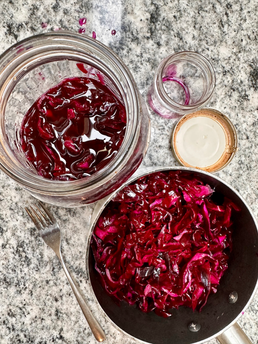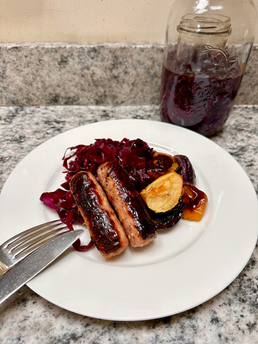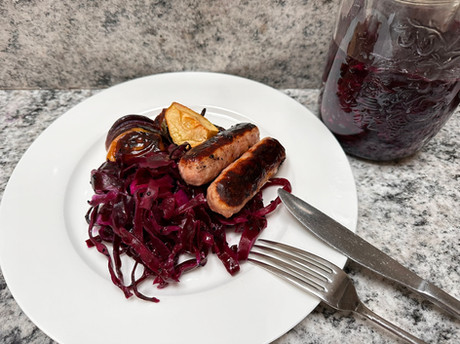Red cabbage sauerkraut with roasted sausages, apples and onion
- Felicity Vincent

- Nov 16, 2024
- 5 min read
My ultimate choucroute: quick, nutritious and comforting.
Homemade red cabbage sauerkraut is warmed through with spices and served with roasted apples, red onion and sausages for the ultimate flavour combo.
This is my take on a Choucroute Alsacienne, a traditional french recipe consisting of warm sauerkraut and a lot of pork meat. I've made it lighter and more nutritious without losing the comforting factor. Serve it up with mustard on a cold night.

Ingredients (serves 4):
Red cabbage sauerkraut recipe:
1 red cabbage
2.5% fine salt
Roasted sausages, apples and onion:
8 sausages
2 apples
1 red onion
1 Tbs oil
1 tsp nigella seeds or cumin seeds
Method:
First up, the homemade sauerkraut. This uses the lacto-fermentation technique which is easier than it sounds.
Divide the red cabbage in half then cut into thin slices.
Wash the cabbage in cold water.
Drain it and weigh it out in a bowl.
Calculate the (cabbage weight) x0.025 = add that calculated weight in salt.
Stir the salt onto all the cabbage and scrunch it up slightly with you hands.
Leave it to sit for 2-3 hours so the salt can draw out the water from the cabbage.
Sterilise a large jar by 'cooking' it in the oven at 180°C for 10 minutes then leaving it to cool.
Stuff the cabbage into the cold jar and pour the water onto it. Press down on the cabbage until it is fully submerged in the water. Use a weight if you can. If there isn't enough water, don't worry, make up a 2.5% salt and water solution to top the jar up with.
Leave the jar on the side for 5 days, making sure to open it and close it back up once every day.
Taste it to see if it's sour enough to your taste then store in the fridge until you're ready to use it.
Peel the onion and quarter it.
Quarter the apples and remove their cores.
Oil a baking sheet, lay out the sausage on it and pierce them all over with a fork.
Add the onion, apple and sage leaves.
Roast in the oven for 20-25 minutes at 180°C or until the sausages are brown all over.
Put about half the sauerkraut in a pan with a few Tbs of the 'juice', spice of your choice (I went for nigella seeds but cumin or cinnamon would be nice too), and warm it up on medium heat for 2-3 minutes.
Serve it all up on a plate and enjoy with a bit of mustard.
Bon appétit!
More about this choucroute recipe:
Shortcuts:
The red cabbage sauerkraut is a great make-ahead. recipe It doesn't take long to prep if you can find the headspace to do it at the weekend. But otherwise, you can use sauerkraut from the supermarket of course.
Once the sauerkraut is done fermenting, this recipe is super quick and easy for a midweek meal.
Keys to success:
I'm not a fermentation expert by any means, not even close. In fact, you can check out my YouTube video about my attempt at making fermented strawberries which -spoiler alert- was a fail. But, sauerkraut is definitely a great entry point and what I'm trying to say is, if I can make it, so can you!
The key is for the cabbage to always be submerged in the salty water to make sure only the good bacteria thrive, and sterilise your jar before using.
If the sauerkraut isn't sour enough, leave it to ferment for a few more days.
Health benefits of red cabbage:
They're a good source of:
vitamin B7 (biotin) which supports cell health and is needed to transform food into energy;
vitamin B9 (folate) which supports the formation of red blood cells and the production of serotonin;
vitamin C which acts as a water-soluble antioxidant, protects cells, enables wound healing and helps maintain healthy skin, bones, cartilage and blood vessels;
vitamin K - which is required for blood clotting to support wound healing, and is necessary to support bone health; it is also required for the synthesis of sphingolipids which play an essential role in brain cell function, recent research has linked sphingolipid health with healthy aging and reduced risk of neurodegenerative disorders such as Alzheimer's and Parkinson's;
manganese which also enables us to release energy from food and supports cell health;
soluble fibre which helps lower blood cholesterol, and slows the release of energy from food, managing blood sugar levels. It also helps bulk stools with water and serves as a prebiotic, meaning it feeds our gut bacteria for a healthy microbiome which has its own multitude of health benefits;
insoluble fibre - helps to make you feel full, and soften stools for better digestive health. It is also associated with phenolic compounds and therefore antioxidant properties.
Red cabbage also contains many other beneficial active compounds such as the pigments that give its distinct colour known as anthocyanins and compounds present in all cabbages, which give its distinct smell, known as glucosinolates (broken down when cut/cooked/digested into other beneficial compounds). These act as anti-oxidants and anti-inflammatories to protect against cancer and chronic diseases such as diabetes, cardiovascular diseases and neurodegenerative diseases (Alzheimer's). But let's take a closer look at their other benefits:
Anthocyanins (polyphenol) - have excellent antioxidant activity which may protect from cancer and age-related diseases including neuronal and cardiovascular ones as well as reducing bone loss. They have also been shown to have protective affects on our GI tract, reducing inflammation and protecting the intestinal barrier (which otherwise might let bad things through), as well as promoting our gut microbiota which in turn has positive effects on our immune system, mental health and weight.
Cyanidins (the anthocyanin present in highest concentration) - also have strong radical-scavenging capabilities which mean they reduce chances of certain types of cancer and reduce physical signs of ageing.
Kaempferol (polyphenol) - shows a positive association with reduced risk of cardiovascular diseases. Early studies have linked it to anti-diabetic properties, and some animal studies have even shown they block the build up of beta-amyloid plaque in the brain which leads to Alzheimer's disease.
Isothiocyanate (a product of the breakdown of glucosinolates) - improves our body's detoxification pathways, making it easier to excrete toxins and carcinogens such as cigarette smoke and pollutants. It has bactericidal properties towards some harmful bacteria, helping our good bacteria thrive. Finally, it has been linked to a reduced risk of cancer, most likely due to promoting cell death (apoptosis) and regulating cell proliferation.
Sulforaphane (a product of the breakdown of glucosinolates) - plays a similar role to isothiocyanate, early animal studies also indicate that it may play a role in kidney health.
Fermentation such as the lacto-fermentation used to make sauerkraut actually increases antioxidant capacity as well. Some shop bought sauerkraut has to be pasteurised so it can be kept at ambient temperature on shelves and this kills off all the good bacteria developed during fermentation. So for maximum benefits and to get all those healthy gut benefits, I recommend trying to make your own from time to time at the weekend. It's also a lot cheaper.
Mood Food - Happy:
Folate - is linked to levels of serotonin, our good mood hormone often linked to a feeling of serenity; and not having enough folate increases the chance of feeling depressed.
Vitamin C - is involved in converting dopamine to noradrenaline - low amounts of noradrenaline are associated with depression.
Vitamin K - Initial studies have shown promising results of a significant inverse relationship between vitamin K and depressive symptoms.
Anthocyanins - inhibit MAO which breaks down dopamine. Excess MAO can sometimes be the cause of depression.
Hopefully this makes you excited to try this and many other winter red cabbage recipes during their season!
You can find lots of ideas on how to cook with red cabbage in my newsletter: https://felicityvincent.substack.com/
Video:
Cook along with this step-by-step video and learn how to make my easy red cabbage sauerkraut choucroute recipe:
Photos:










Comments